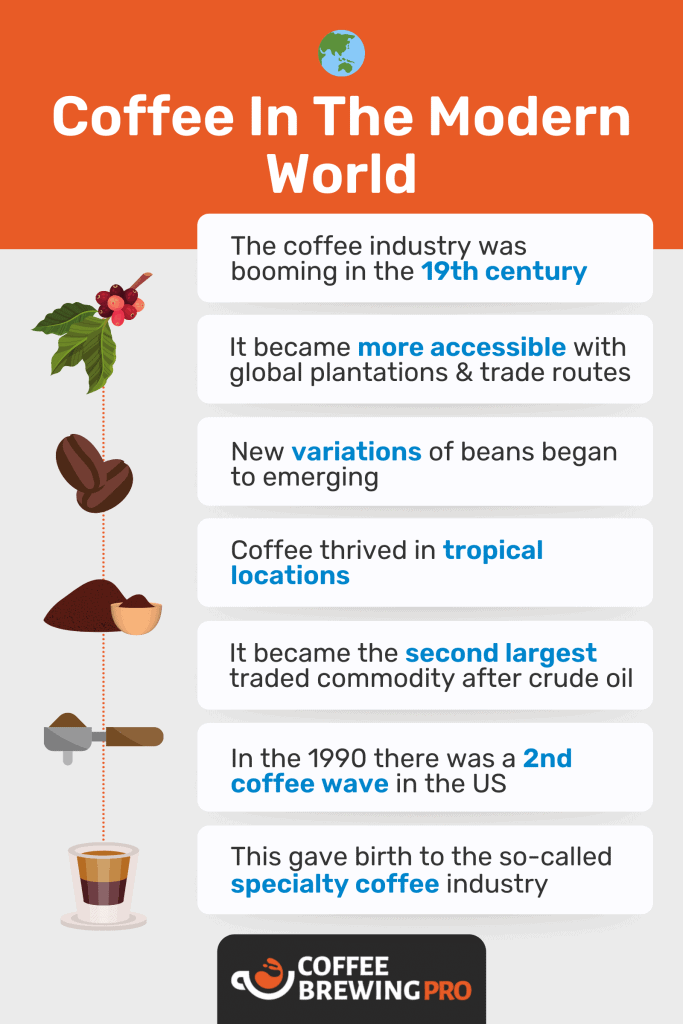
What is the history of coffee? To many coffee enthusiasts, coffee is an essential part of our daily routine. I couldn’t imagine life without it. But where did it come from?
If you look online, you’ll find different versions of historical events and timelines. Unfortunately, many of them lack evidence and credibility.
The history of coffee is a long and complicated one. Which has since become a multi-billion dollar empire that spans the globe. It has become the second-largest commodity traded after crude oil.
Coffee has had its fair share of controversy along the way. Keep reading to learn more.
Where Was Coffee Discovered? – An Ethiopian Legend

Coffee originates from Ethiopia estimated around 850 AD. It all starts with an Ethiopian legend including a goat herder named Kaldi. According to the legend, Kaldi stumbled across his goats acting strangely one day. They were jumping around after they had been eating red berries from a tree. He decided to try some for himself and felt invigorated.
After making this discovery Kaldi filled his pockets and reported it to a local monk. At first, he did not receive the warm welcome he was anticipating. The monk throws the fruits in the fire saying it is the work of the Devil. The aroma from the roasting coffee started to fill the air and intrigued the monk.
The monk then decided to make a drink out of the berries. He was having difficulty staying awake through the long evening prayer. The monk was pleasantly surprised by the outcome. He shared this knowledge with other monks on his travels. The knowledge of this wonder berry started to spread and eventually reached the Middle East.
The legend of Kaldi is simply that… A legend. The earliest texts found containing this story come from 1671, with hundreds of years between. There is no way to verify how true it is. Although other origin stories are all centered around Ethiopia and Yemen. The story of Kaldi is the most popular by far.
Modern technology advancements have allowed us to trace coffee origins back to Africa.
Some historians believe that coffee beans were mixed with ghee and chewed as a stimulant for centuries before they were ever brewed. It was common for many Ethiopian tribes in the 10th century to eat coffee in a thick paste-like porridge.
As time went on, eating coffee became less common. The coffee beverage became the main method of consuming coffee.
The Middle East
Yemen
Coffee spread very quickly throughout the Arabian peninsula. Yemen’s climate offered ideal conditions to cultivate coffee. Some early sources mention that coffee was present in Yemen around the 15th century. Information indicates that some Arabians had been using the coffee cherries to make wine for a few hundred years already.
Coffee first arrived in Yemen at the port of Mocha which borders the Red Sea.
Does that sound familiar?
Mocha has become associated with coffee because of the large amounts of coffee beans that were exported from the port of Mocha. Referred to as the Mocha bean.
Istanbul
Coffee was then introduced to Istanbul around 1555. There are two legends of how it traveled across lands. One version mentions the Ottoman governor of Yemen discovering coffee whilst at a local coffee shop. He grew fond of it and sent it to the Sultan who shared the same love for it.
The second version involves Yemeni traders setting up coffee shops in Istanbul. These paved the way for the growth of coffee.
In Istanbul, a new method of drinking coffee was discovered. Coffee beans were roasted, ground, and brewed in hot water. This unlocked a whole new perspective to the coffee experience with stronger flavors and aromas. This helped coffee earn its popularity and worked its way from the palaces to homes all over.
Coffee houses became social hubs that were ingrained in society. People would come to enjoy a great brew with friends throughout Egypt, Syria, and Ethiopia. It was known as the “wine of Araby” and coffee houses were known as “Schools of the Wise”.
As coffee spread there were attempts to ban it in certain Muslim regions in the early 1500s, due to its stimulating effect. Although this was followed by outrage each time and was overturned.
By the end of the 16th century, coffee had spread throughout the rest of the Middle East, Persia, and Turkey.
Coffee Cultivation Around The World
Asia
Up until this point, Arabia was a monopoly for coffee production. All beans were directly purchased and exported from Yemen. They were able to keep control and prices high. They would roast and bake all beans before exporting to ensure the beans wouldn’t grow if planted.
As demand started to increase there was a push to start cultivating coffee outside of Arabia.
Enter Baba Budan. He was a Sufi Saint from India on his pilgrimage to Mecca. Along his way, he managed to get his hands on some green, unroasted coffee beans and smuggled them back home.
Once he reached India he began planting and cultivating coffee in the South in a town called Mysore. Coffee cultivation expanded to other towns nearby and became a large-scale operation.
Towards the end of the 17th century, the Dutch were able to smuggle some seedlings in an attempt to grow their trees in Ceylon, Sri Lanka. They had colonized large parts of India, followed by the British. They saw a great business opportunity to capitalize off of coffee production. These plantations were later abandoned and relocated to their outposts in Java, Indonesia.
These outposts became a key supplier to Europe for their coffee. The coffee plantations continued to expand to Sumatra and Celebes to meet the worldwide demand. They started to import large quantities into Europe and were able to lower the prices. As coffee became more affordable and accessible the demand shot up.
Europe
Travelers and merchants passing through Istanbul spread the word about this unusual black beverage. Stories traveled all over Europe and Asia. It moved West into Italy and East into India and Indonesia.
It arrived in Venice in 1570 and people were fearful of coffee because of its stimulating properties and bitterness. The debates became so heated that Pope Clement VIII was asked to intervene. Before making a decision he wanted to try the drink for himself. He found it to be so delicious that papal approval was granted in 1615.
Through all this controversy, coffee houses were opening up across all major European cities. Including England, Austria, France, Germany, and Holland. Coffee was starting to become the beverage of choice for many people all over the world and replaced the likes of beer and wine (the breakfast drink of choice at the time).
People found that starting their day with a good brew improved their productivity. They were more alert and energized for their day ahead.
Similar to the Arabian coffee houses, coffee houses in Europe became social epicenters crucial to society. They were a place of intellectual conversations, debates, business meetings, and much more. In England, they became known as penny universities.
They received this name because for the price of a penny you could buy a cup of coffee and soak in the wealth of knowledge that surrounded you. These coffee houses were full of writers, artists, lawyers, poets, philosophers, and politicians.
They opened the doors to innovation where many businesses grew out from. Lloyd’s of London came into fruition at Edward Lloyd’s coffee house for example.
Coffee houses became so popular that in 1674 a petition to ban coffee was created by women to bring their men back home.
Coffee was then introduced into France around 1669 by the Turkish ambassador to the court of King Louis XIV of France. He had brought over several sacks of coffee which quickly helped him become a member of high society. He would invite guests over for stimulating conversation and a good brew where they quickly fell in love with coffee.
Coffee came to France officially in 1714. The mayor of Amsterdam gifted King Louis XIV of France a young coffee plant. This was later planted in the Royal Botanical Garden in Paris.
A few years later in 1723, the coffee plant was on the move again. Gabriel de Clieu was a young naval officer who managed to get ahold of some coffee seedlings from the King’s plantation. The means by which he acquired them are unknown.
He then voyaged to the island of Martinique to establish a coffee plantation in the Caribbean. Along the way, he was faced with many challenges and had to ration water to keep the plant alive. Once he got there he found that the growing conditions and climate were perfect for the plant to thrive.
From that original coffee plant came 18 million more on the island of Martinique in the short span of 50 years. Coffee plantations further spread through St Dominique and Guadalupe.
It’s amazing to think that one parent seedling went on to populate all of the coffee trees throughout the Caribbean, South, and Central America.
The New World
Brazil
Coffee expanded into Brazil in 1727. This is all thanks to a Portuguese sailor named de Mello Palheta. He transported coffee seedlings from French Guiana over to Brazil for cultivation as ordered by the emperor to French Guiana.
Although it wasn’t as simple as that. The French were reluctant to hand over the coffee and de Mello wasn’t planning on going back empty-handed. He decided to charm the French governor’s wife. She fell victim to his good looks and decided to give him a bunch of coffee seeds secretly.
Those few seeds were the start of the billion-dollar coffee industry in Brazil. Since 1852 Brazil has been the largest producer of coffee. Producing over 35% of the world’s coffee.
The Americas
In the mid-17th century, coffee was brought to New York, which was previously known as New Amsterdam. Although coffee houses only started to emerge after 1773.
Until the Boston Tea Party revolt in 1773 against the heavy tax on tea, tea was the beverage of choice. Since then coffee was associated with being the patriotic drink of the civilized world.
America imports and consumes more coffee than any other nation to this day.
Kona coffee was later born in Hawaii in 1825 after the first seedlings had been brought over by the Brazilians.
Coffee In The Modern World

By the start of the 19th century, the coffee industry was booming. There were global plantations and trade routes established everywhere. It was becoming more accessible and different variations of beans were emerging. Travelers and traders continued to carry the coffee seeds to new destinations.
Coffee thrived in tropical locations atop mountains and hillsides. Coffee became the second largest traded commodity after crude oil. As coffee continued to spread, demand continued to increase until it became what it is today.
In the 1990s there was a 2nd coffee wave that spread throughout the United States of America. Big coffee shops like Starbucks were growing rapidly.
This second wave gave birth to the so-called specialty coffee industry. Consumers were becoming more fascinated in learning the history of coffee and making it a more ethical process.
Roasting and grinding their coffee beans became the norm.
Specialty coffee became synonymous with ethical and sustainable coffee cultivation. Making a huge difference for coffee farmers all over the world.
The Bottom Line
Now you’ve got the rundown, we hope that the information above provides you with a clearer picture of the history of coffee.
Since the birth of traditional coffee in 850 AD, it has come a long way. From dancing goats and monks in Ethiopia to bearded baristas worldwide.
What a time to be alive!
Read more about the 4 different types of coffee beans, where they come from, and find out which beans you should pick.






